Papers by Antonello Mallamaci
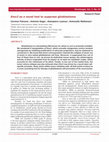
Glioblastoma is a devastating CNS tumour for which no cure is presently available. We wondered if... more Glioblastoma is a devastating CNS tumour for which no cure is presently available. We wondered if manipulation of Emx2, which normally antagonizes cortico-cerebral astrogenesis by inhibiting proliferation of astrocyte progenitors, may be employed to counteract it. We found that Emx2 overexpression induced the collapse of seven out of seven in vitro tested glioblastoma cell lines. Moreover, it suppressed four out of four of these lines in vivo. As proven by dedicated rescue assays, the antioncogenic activity of Emx2 originated from its impact on at least six metabolic nodes, which accounts for the robustness of its effect. Finally, in two out of two tested lines, the tumor culture collapse was also achieved when Emx2 was driven by a neural stem cell-specific promoter, likely active within tumor-initiating cells. All that points to Emx2 as a novel, promising tool for therapy of glioblastoma and prevention of its recurrencies.
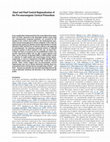
Cerebral Cortex, 2002
It has recently been demonstrated that the transcription factor genes Emx2 and Pax6, expressed in... more It has recently been demonstrated that the transcription factor genes Emx2 and Pax6, expressed in the developing cerebral cortex along two complementary tangential gradients, are essential for the shaping of the cortical areal profile at late developmental ages, when cortical neuronogenesis is almost completed. In this study we addressed the question of whether cortical regionalization is already affected in Emx2 and Pax6 loss of function mutants at the beginning of neuronogenesis. By comparing expression patterns of selected molecular markers in these mutants at this age, we found that: (i) Emx2 and Pax6 are necessary for the establishment of their own specific expression profiles and are able to down-regulate each other; and (ii) absence of functional EMX2 or PAX6 proteins results in reduction of caudal-medial and rostral-lateral cortical regions, respectively, as well as in impairment of the WNT signalling center at the medial-caudal edge of the cortical field, crucial for cortical growth. These results suggest that pre-neuronogenic cortical regionalization may rely on mutual interactions between these two transcription factors and that the late areal phenotype of Emx2 -/and Pax6 -/mutants may possibly arise from both misconfiguration of the cortical molecular protomap and distortion of the cortical growth profile.
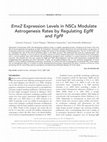
Generation of astrocytes within the developing cerebral cortex is a tightly regulated process, in... more Generation of astrocytes within the developing cerebral cortex is a tightly regulated process, initiating at low level in the middle of neuronogenesis and peaking up after its completion. Astrocytic outputs depend on two primary factors: progression of multipotent precursors toward the astroglial lineage and sizing of the astrogenic proliferating pool. The aim of this study was to investigate the role of the Emx2 homeobox gene in the latter process. We addressed this issue by combined gain-and loss-of-function methods, in vivo as well as in primary cultures of cortico-cerebral precursors. We found that Emx2 overexpres-sion in cortico-cerebral stem cells shrinked the proliferating astrogenic pool, resulting in a severe reduction of the astroglial outcome. We showed that this was caused by EgfR and Fgf9 downregulation and that both phenomena originated from exaggerated Bmp signaling and Sox2 repression. Finally, we provided evidence that in vivo temporal progression of Emx2 levels in cortico-cerebral multipotent precursors contributes to confine the bulk of astrogenesis to postnatal life. Emx2 regulation of astrogenesis adds to a number of earlier developmental processes mastered by this gene. It points to Emx2 as a new promising tool for controlling reactive astrogliosis and optimizing cell-based designs for brain repair.
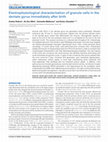
Frontiers in Cellular Neuroscience, 2014
Granule cells (GCs) in the dentate gyrus are generated mainly postnatally. Between embryonic day ... more Granule cells (GCs) in the dentate gyrus are generated mainly postnatally. Between embryonic day 10 and 14, neural precursors migrate from the primary dentate matrix to the dentate gyrus where they differentiate into neurons. Neurogenesis reaches a peak at the end of the first postnatal week and it is completed at the end of the first postnatal month. This process continues at a reduced rate throughout life. Interestingly, immediately after birth, GCs exhibit a clear GABAergic phenotype. Only later they integrate the classical glutamatergic trisynaptic hippocampal circuit. Here, whole cell patch clamp recordings, in current clamp mode, were performed from immature GCs, intracellularly loaded with biocytin (in hippocampal slices from P0 to P3 old rats) in order to compare their morphological characteristics with their electrophysiological properties. The vast majority of GCs were very immature with small somata, few dendritic branches terminating with small varicosities and growth cones. In spite of their immaturity their axons reached often the cornu ammonis 3 area. Immature GCs generated, upon membrane depolarization, either rudimentary sodium spikes or more clear overshooting action potentials that fired repetitively. They exhibited also low threshold calcium spikes. In addition, most spiking neurons showed spontaneous synchronized network activity, reminiscent of giant depolarizing potentials (GDPs) generated in the hippocampus by the synergistic action of glutamate and GABA, both depolarizing and excitatory. This early synchronized activity, absent during adult neurogenesis, may play a crucial role in the refinement of local neuronal circuits within the developing dentate gyrus.
Nature neuroscience, 2002
Progress in Brain Research, 2011
This chapter will focus on molecular mechanisms governing early steps of cortico-cerebral arealiz... more This chapter will focus on molecular mechanisms governing early steps of cortico-cerebral arealization. This is a very complex and intricate field, in which a great number of experimental investigations have been performed and vigorous scientific debates have taken place in recent years. We will try to provide an organic synthesis of this subject, summarizing the main experimental results and their theoretical implications.

The International Journal of Developmental Biology, 2013
A remarkable body of research over the last 15 years has been aimed at disentangling the cellular... more A remarkable body of research over the last 15 years has been aimed at disentangling the cellular and molecular mechanisms which regulate murine cortico-cerebral astrogenesis. This research effort has allowed the reconstruction of the actual sizing of this process, as well as a better definition of its temporal, spatial and clonal articulation. Moreover, these investigations have shed substantial light on the cardinal molecular mechanisms governing the transition from pallial neuronogenesis to astrogenesis, as well as subsequent progress of the latter. It has turned out that proper temporal articulation of astrogenesis relies on a plethora of tightly interlaced mechanisms, which synergistically dampen astrogenesis prior to birth and promote it during peri- and postnatal life. The aim of this review is to provide a comprehensive and organic synthesis of these mechanisms, as well as a critical evaluation of their specific relevance to proper articulation of cerebral cortex astrogenesis in time and space.
PLoS ONE, 2010
Background: Emx2 encodes for a transcription factor expressed in the embryonic intermediate mesod... more Background: Emx2 encodes for a transcription factor expressed in the embryonic intermediate mesoderm and central nervous system (CNS). It is implicated in several aspects of cerebral cortex development, including morphogenetic field specification, arealization, precursor proliferation and lamination. Four Emx2-associated antisense transcripts have been found in the urogenital system; one of them, Emx2OS, has been also detected in the adult brain. Until now, however, nothing is known about expression and function of Emx2OS in the developing CNS.

Neural Development, 2009
Glutamatergic neurons of the murine cerebral cortex are generated within periventricular prolifer... more Glutamatergic neurons of the murine cerebral cortex are generated within periventricular proliferative layers of the embryonic pallium, directly from apical precursors or indirectly via their basal progenies. Cortical neuronogenesis is the result of different morphogenetic subroutines, including precursor proliferation and death, changes in histogenetic potencies, and post-mitotic neuronal differentiation. Control of these processes is extremely complex, involving numerous polypeptide-encoding genes. Moreover, many so-called 'non-coding genes' are also expressed in the developing cortex. Currently, their implication in corticogenesis is the subject of intensive functional studies. A subset of them encodes microRNAs (miRNAs), a class of small RNAs with complex biogenesis that regulate gene expression at multiple levels and modulate histogenetic progression and are implicated in refinement of positional information. Among the cortical miRNAs, miR-124 has been consistently shown to promote neuronogenesis progression in a variety of experimental contexts. Some aspects of its activity, however, are still controversial, and some have to be clarified. An in depth in vivo characterization of its function in the embryonic mammalian cortex is still missing. By integrating locked nucleic acid (LNA)-oligo in situ hybridization, electroporation of stage-specific reporters and immunofluorescence, we reconstructed the cortico-cerebral miR-124 expression pattern during direct neuronogenesis from apical precursors and indirect neuronogenesis via basal progenitors. The miR-124 expression profile in the developing embryonic cortex includes an abrupt upregulation in apical precursors undergoing direct neuronogenesis as well as a two-step upregulation in basal progenitors during indirect neuronogenesis. Differential post-transcriptional processing seems to contribute to this pattern. Moreover, we investigated the role of miR-124 in embryonic corticogenesis by gain-of-function approaches, both in vitro, by lentivirus-based gene transfer, and in vivo, by in utero electroporation. Following overexpression of miR-124, both direct neuronogenesis and progression of neural precursors from the apical to the basal compartment were stimulated. We show that miR-124 expression is progressively up-regulated in the mouse embryonic neocortex during the apical to basal transition of neural precursor cells and upon their exit from cell cycle, and that miR-124 is involved in the fine regulation of these processes.
Neural Development, 2010
Background: The metatherian Monodelphis domestica, commonly known as the South-American short-tai... more Background: The metatherian Monodelphis domestica, commonly known as the South-American short-tailed opossum, is an appealing animal model for developmental studies on cortico-cerebral development. Given its phylogenetic position, it can help in tracing evolutionary origins of key traits peculiar to the eutherian central nervous system. The capability of its pup to regenerate damaged cortico-spinal connections makes it an ideal substrate for regenerative studies. Recent sequencing of its genome and the ex utero accessibility of its developing cerebral cortex further enhance its experimental interest. However, at the moment, a comprehensive cellular and molecular characterization of its cortical development is missing.
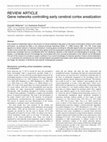
European Journal of Neuroscience, 2006
Early thalamus-independent steps in the process of cortical arealization take place on the basis ... more Early thalamus-independent steps in the process of cortical arealization take place on the basis of information intrinsic to the cortical primordium, as proposed by Rakic in his classical protomap hypothesis [Rakic, P. (1988) Science, 241, 170-176]. These steps depend on a dense network of molecular interactions, involving genes encoding for diffusible ligands which are released around the borders of the cortical field, and transcription factor genes which are expressed in graded ways throughout this field. In recent years, several labs worldwide have put considerable effort into identifying members of this network and disentangling its topology. In this respect, a considerable amount of knowledge has accumulated and a first, provisional description of the network can be delineated. The aim of this review is to provide an organic synthesis of our current knowledge of molecular genetics of early cortical arealization, i.e. to summarise the mechanisms by which secreted ligands and graded transcription factor genes elaborate positional information and trigger the activation of distinctive area-specific morphogenetic programs.
European Journal of Human Genetics, 2013

Journal of Neuroscience, 2005
It has been suggested that cerebral cortex arealization relies on positional values imparted to e... more It has been suggested that cerebral cortex arealization relies on positional values imparted to early cortical neuroblasts by transcription factor genes expressed within the pallial field in graded ways. Foxg1, encoding for one of these factors, previously was reported to be necessary for basal ganglia morphogenesis, proper tuning of cortical neuronal differentiation rates, and the switching of cortical neuroblasts from early generation of primordial plexiform layer to late production of cortical plate. Being expressed along a rostral/lateral(high)- to-caudal/medial(low) gradient, Foxg1, moreover, could contribute to shaping the cortical areal profile as a repressor of caudomedial fates. We tested this prediction by a variety of approaches and found that it was correct. We found that overproduction of Cajal-Retzius neurons characterizing Foxg1-/- mutants does not arise specifically from blockage of laminar histogenetic progression of neocortical neuroblasts, as reported previously, but rather reflects lateral-to-medial repatterning of their cortical primordium. Even if lacking a neocortical plate, Foxg1-/- embryos give rise to structures, which, for molecular properties and birthdating profile, are highly reminiscent of hippocampal plate and dentate blade. Remarkably, in the absence of Foxg1, additional inactivation of the medial fates promoter Emx2, although not suppressing cortical specification, conversely rescues overproduction of Reelin(on) neurons.
International Journal of Developmental Neuroscience, 2010
Neural stem cells (NSCs) give rise to all cell types forming the cortex, neurons, astrocytes and ... more Neural stem cells (NSCs) give rise to all cell types forming the cortex, neurons, astrocytes and oligodendrocytes. The transition from the former to the latter ones takes place via lineage-restricted progenitors and is mastered by large sets of genes, among which some implicated in CNS pattern formation. Aim of this study was to disentangle the kinetic and histogenetic roles exerted by two of these genes, Emx2 and Foxg1, in cortico-cerebral precursors.
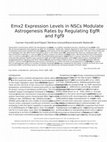
Glia, 2014
Generation of astrocytes within the developing cerebral cortex is a tightly regulated process, in... more Generation of astrocytes within the developing cerebral cortex is a tightly regulated process, initiating at low level in the middle of neuronogenesis and peaking up after its completion. Astrocytic outputs depend on two primary factors: progression of multipotent precursors toward the astroglial lineage and sizing of the astrogenic proliferating pool. The aim of this study was to investigate the role of the Emx2 homeobox gene in the latter process. We addressed this issue by combined gain-and loss-of-function methods, in vivo as well as in primary cultures of cortico-cerebral precursors. We found that Emx2 overexpression in cortico-cerebral stem cells shrinked the proliferating astrogenic pool, resulting in a severe reduction of the astroglial outcome. We showed that this was caused by EgfR and Fgf9 downregulation and that both phenomena originated from exaggerated Bmp signaling and Sox2 repression. Finally, we provided evidence that in vivo temporal progression of Emx2 levels in cortico-cerebral multipotent precursors contributes to confine the bulk of astrogenesis to postnatal life. Emx2 regulation of astrogenesis adds to a number of earlier developmental processes mastered by this gene. It points to Emx2 as a new promising tool for controlling reactive astrogliosis and optimizing cell-based designs for brain repair. GLIA 2014;00:000-000

STEM CELLS, 2010
Neural stem cells (NSCs) give rise to all cell types forming the cortex: neurons, astrocytes, and... more Neural stem cells (NSCs) give rise to all cell types forming the cortex: neurons, astrocytes, and oligodendrocytes. The transition from the former to the latter ones takes place via lineage-restricted progenitors in a highly regulated way. This process is mastered by large sets of genes, among which some implicated in central nervous system pattern formation. The aim of this study was to disentangle the kinetic and histogenetic roles exerted by two of these genes, Emx2 and Foxg1, in cortico-cerebral precursors. For this purpose, we set up a new integrated in vitro assay design. Embryonic cortical progenitors were transduced with lentiviral vectors driving overexpression of Emx2 and Foxg1 in NSCs and neuronal progenitors. Cells belonging to different neuronogenic and gliogenic compartments were labeled by spectrally distinguishable fluoroproteins driven by cell type-specific promoters and by cell type-specific antibodies and were scored via multiplex cytofluorometry and immunocytofluorescence. A detailed picture of Emx2 and Foxg1 activities in cortico-cerebral histogenesis resulted from this study. Unexpectedly, we found that both genes inhibit gliogenesis and promote neuronogenesis, through distinct mechanisms, and Foxg1 also dramatically stimulates neurite outgrowth. Remarkably, such activities, alone or combined, may be exploited to ameliorate the neuronal output obtainable from neural cultures, for purposes of cell-based brain repair.
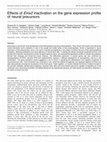
European Journal of Neuroscience, 2006
Emx2 plays a crucial role in the development of the diencephalon and dorsal telencephalon. Thus, ... more Emx2 plays a crucial role in the development of the diencephalon and dorsal telencephalon. Thus, Emx2-null mutants have abnormal cortical lamination and a reduction in size of the caudal and medial areas of the prosencephalon. Emx2 is expressed in neural precursors of the subventricular zone in vivo and in cultured neurospheres in vitro where it controls the size of the transit-amplifying population, affecting proliferation and clonal efficiency of neural stem cells. To identify the cellular processes mastered by Emx2, and possibly the molecular mechanisms by which the gene exerts its action, we compared the expression profile of cultured neurospheres derived from wild-type and Emx2-null mouse embryos. The differential expression of several genes was also confirmed by semiquantitative RT-PCR, real-time PCR and cytofluorimetric analysis in different preparations of neurospheres, and by in situ hybridization. The gene expression profile suggested a role for Emx2 in regulating the differentiation and migration properties of neural precursor cells. This involvement was confirmed in vitro, where the altered clonogenicity and impaired migration of Emx2-null cells were partially corrected by transduction of the Emx2 gene. Taken together, our results indicate that Emx2 is indeed involved in the transition between resident early progenitors (perhaps stem cells) and more mature precursors capable of migrating out of the ventricular zone, becoming postmitotic and differentiating into the appropriate cell type, and help explain the alterations observed in the brains of knock-out mice.

Current Gene Therapy, 2013
Emx2 encodes for a transcription factor controlling several aspects of cerebral cortex developmen... more Emx2 encodes for a transcription factor controlling several aspects of cerebral cortex development. Its overexpression promotes self-renewal of young cortico-cerebral precursors, it promotes neuronal rather than gliogenic fates and it protects neuronal progenitors from cell death. These are all key activities for purposes of gene-promoted brain repair. Artificial pri-miRNAs targeting non-coding cis-active modules and/or conserved sequences of the Emx2 locus were delivered to embryonic cortico-cerebral precursors, by lentiviral vectors. A subset of these pri-miRNAs upregulated Emx2, possibly stimulating its transcription. That led to enhanced self-renewal, delayed differentiation and reduced death of neuronally committed precursors, resulting in an appreciable expansion of the neuronogenic precursors pool. This method makes Emx2 overexpression for purposes of brain repair a more feasible goal, avoiding the drawbacks of exogenous gene copies introduction. Interestingly, the two genomic enhancers targeted by these pri-miRNAs were discovered to be naturally transcribed. Their expression profile suggests their possible involvement in regulation of Emx2 transcription.

Cerebral Cortex, 2003
Three basic aspects of cerebral cortex development - specification of cortical versus ganglionic ... more Three basic aspects of cerebral cortex development - specification of cortical versus ganglionic identity, regionalization of the early cortical primordium and arealization of the developing cortex - were the main subject of our recent investigations. We previously demonstrated that the two homeobox genes Emx2 and Pax6 promote development of caudal-medial and rostral-lateral cortex, respectively, by properly shaping the early cortical protomap and possibly modulating the tangential growth ratio between medial and lateral cortical anlagen. More recently, by analyzing the brains of embryos bearing mutations for Emx2 and Pax6 in different combinations, we found that both genes are necessary and sufficient for a more basic developmental choice, i.e. the specification of neuroblasts in the dorsal telencephalon as cortical versus ganglionic neuroblasts. Finally, we explored the possible roles of the Emx2 paralog, Emx1, in these processes. By looking at embryos mutant for Emx1, Emx2 and Pax6 in various combinations, we did not get any evidence of Emx1 involvement in the process of cortical specification; conversely, this gene appeared to be involved to some extent in the process of regionalization of the cortical primordium along the medial-lateral axis, as a promoter of medial fates.

Uploads
Papers by Antonello Mallamaci